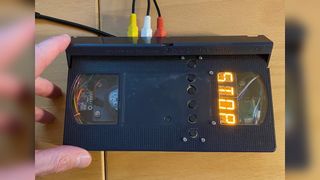
If you're looking to emulate old-school technology, there's likely no board better suited than a Raspberry Pi. Its affordability and vast online community provide many support options for add-ons and more. It should come as no surprise that maker and developer Alan Boris used one to help create this incredible VHS composite video player and recorder project.
According to Boris, the idea came to him when the need arose for a basic composite video player. Instead of purchasing something already made for the job, he decided creating one from scratch would be much more fun. In this case, he built a Pi-powered composite video player and managed to fit all of the hardware inside of a VHS tape.
The tape has been modified quite extensively to suit the project's needs. It has an LED display and buttons that can control media by pausing, playing, rewinding, etc. Because the project is housed inside an old tape, Boris thought it would be fun to include a spinning reel that moves when videos are being played.


The Pi model used in this project is a Raspberry Pi 3 A+. This board has a smaller form factor than the 3 B+, making it easier to place inside the tape. It's connected to the LED display, a couple of RCA jacks, a handful of buttons, and a DRV8833 motor drive that rotates the reel with a servo motor.
Boris was kind enough to make the project open source and shared all of the code at GitHub. He recommends compiling the code and flashing it to the Pi using Balena. You can find more details about the project and how to recreate it for yourself over at Hackster. If you want a closer look at this Raspberry Pi project, you can see it in action over at YouTube, where you can also follow Boris for more cool creations as well as any future updates to this one.
Stay On the Cutting Edge: Get the Tom's Hardware Newsletter
Join the experts who read Tom's Hardware for the inside track on enthusiast PC tech news — and have for over 25 years. We'll send breaking news and in-depth reviews of CPUs, GPUs, AI, maker hardware and more straight to your inbox.

Ash Hill is a Freelance News and Features Writer with a wealth of experience in the hobby electronics, 3D printing and PCs. She manages the Pi projects of the month and much of our daily Raspberry Pi reporting while also finding the best coupons and deals on all tech.
-
bit_user Cute, but the most '733T points would've been awarded if they'd integrated a 1-D electromagnetic interface that a VCR's head could actually read the signal off of. Then, you could pop it in a VCR and watch it as if it were a real tape... sort of like those audio cassette adapters that used to exist for playing musing off a portable audio device in a car that had only a cassette player.Reply
The tricky part is that it needs to be at least 1-D array, since VCRs use helical scan. Each sweep of the head corresponds to a scanline on the screen. That's why VHS tapes were so thick.
Most Popular




